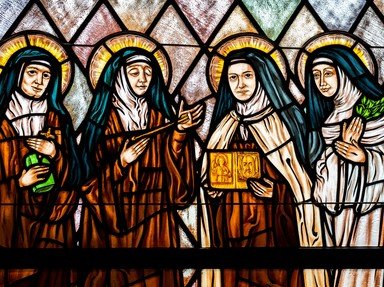Quiz Answer Key and Fun Facts
1. At the age of 13, Wenceslaus became Duke of Bohemia, succeeding his father. Its capital city, now capital of a modern European country, hosts a statue of Wenceslaus at the head of the square that also bears his name. In which city, of which Wenceslaus is patron saint, would you find this square?
2. For which occupation, one for which the Czech Republic is renowned, is Wenceslaus the patron saint?
3. The Catholic church celebrates St. Wenceslaus's Day on September 28th. What day does this commemorate?
4. Wenceslaus was brought up by his grandmother, following his father's death. She ensured that he was raised as a Christian, against the wishes of his mother, Drahomira, who is believed to have reverted to her pagan beliefs following her husband's death. In order to gain her son back, Drahomira had her mother-in-law murdered. What was the name of the slain Duchess, whose martyrdom resulted in canonisation soon afterwards?
5. In the early days of his rule, Wenceslaus was prepared to lay his life on the line in order to protect his soldiers and his people. When Radslav, Duke of Kourim attempted to take over Wenceslaus's kingdom, Wenceslaus challenged him to a duel rather than have his subjects fight in a war. When the time came to fight the duel, Radslav threw his sword aside and accepted defeat. Why did he do this?
6. Wenceslaus built a church in his castle. Initially the intent was to dedicate the church to the Bavarian saint, Emmeram. However, Wenceslaus was given a gift by King Henry the Fowler of Saxony; a relic of a Saxon saint who is one of the Fourteen Holy Helpers of the Catholic church. To which saint, who is commonly celebrated in dance, was this church dedicated?
7. Legend attests of the Duke's custom of secretly taking firewood from his own forests and gifting it to the poor and needy of his kingdom in winter. His own gamekeeper noticed that the wood was going missing, so he reported his concerns to Wenceslaus. How did Wenceslaus respond?
8. The battle for control of Bohemia led to the tragically early demise of Wenceslaus in 935. Lured to his brother Boleslav's castle, for a celebration feast for saints Cosmas and Damian, he never returned home alive. He was ambushed at the one place Boleslav knew Wenceslaus would be without his guards. Where did the ambush take place?
9. A chapel was dedicated to Wenceslaus in the cathedral that was built in his former castle. Which king, the first Bohemian to be Holy Roman Emperor, chose to commemorate him in this way?
10. A legend says that at a time when his motherland is in danger, Wenceslaus's statue will come to life to defend it. To help him in this endeavour will be an army on horseback who live within one of Bohemia's mountains. What is the name of these riders who will help bring eternal peace to the country?
Source: Author
Snowman
This quiz was reviewed by FunTrivia editor
CellarDoor before going online.
Any errors found in FunTrivia content are routinely corrected through our feedback system.
